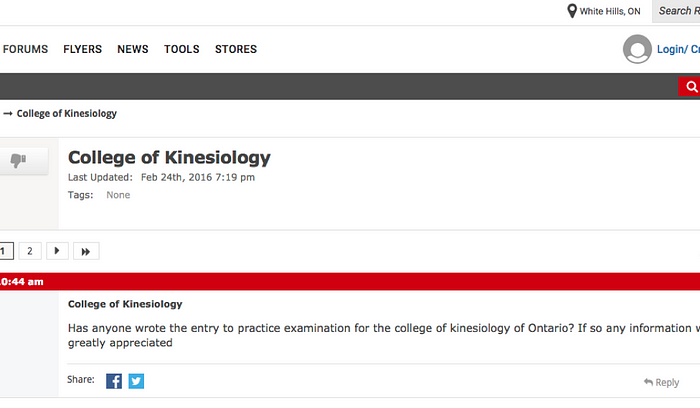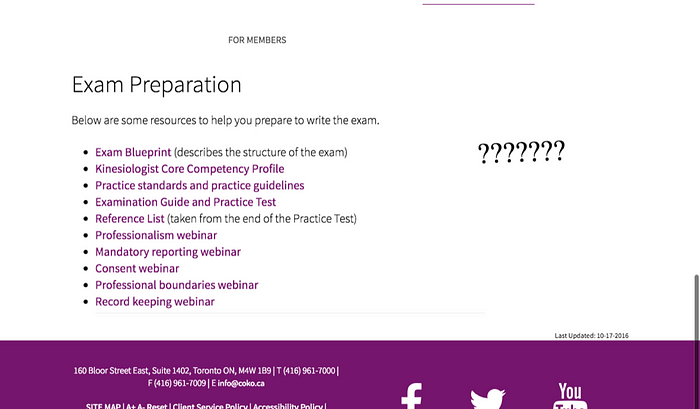
How to study for the Registered Kinesiologist (R.Kin) COKO exam in Ontario
See: https://spennyraposo.medium.com/how-to-study-for-the-registered-kinesiologist-r-kin-exam-in-ontario-35ec8e077994v for original article.
Looking to write the next Registered Kinesiology COKO Exam?
Or are you already a Registered Kinesiologist in Ontario?
Scroll to the bottom to find the link to our Kinesiology Community to help you write the exam or start practicing in Ontario!
@kinformationonline

How to Study For The COKO R.Kin Exam In Ontario [FREE PREP COURSE]
FREE Video Course AVAILABLE NOW ON YOUTUBE — link above
Please subscribe, like and comment!

Best Resources for the R.Kin Exam here
Kinesiology Exam Review here
Registered Kinesiologist Practice Exam: Link
Registered Kinesiologist Study Guide: Link
How to study for the COKO Exam
I was a student like you googling for information about the R. Kin exam. Upon searching I didn’t find many resources. Some would charge you for crappy practice tests or an expensive in-person workshop. To be honest, being a student I really wanted to find my answers somewhere else where I didn’t have to pay more money (aka why I made this resource). Upon searching further I found some forum post discussing the exam.

But no definite answers were found.

I did however manage to message some people who posted about how they wrote the exam and I asked them some questions.

The College website had some insight but these sources were not very helpful at all. They had such vague information that really didn’t help. So going into the exam I had no idea what to expect and if what I studied was good enough to get me a passing mark…
What I have created here was something to help kinesiology students looking to write the exam a chance to know what to expect and how myself and others studied for the COKO R.Kin exam.
BUT, before you start studying, here is a basic overview on how to register and apply to write the exam.
Steps to Register

How to Pay

During each step payment gets confusing. The payment will either appear in your cart or it will appear in your billing. If it doesn’t appear (like it did for me) then just call the college or email them that the pay button or option is not available and they will allow your account to pay.
How to Study for the Exam

Exam Study Resources: Practice Test, Undergrad Notes and Google. Online there are some prep courses available. I found the best way was to use the practice test to look at what you need to study. I will show you in the next section how.
Study Breakdown

Study Breakdown: Jurisprudence

The Jurisprudence quiz is a good resource to help you understand the jurisprudence sections of the exam. On the COKO website is all the notes. I printed them all off and would read through them, highlighting important parts. As long as you have a basic understanding then this section of the exam should not be difficult.
Study Breakdown: Do the Practice Exam

Many people would usually do the practice exam last after they have studied. I think the practice exam should be done first. Let me explain.
After going through the practice exam without studying I was able to see which areas I was comfortable in (aka had to focus less) and which areas I really needed to focus my studies on.
The best part is you can go back and do the practice test again after you go through the next section and see how much you have learned from this method.
Most of the people I know who passed the exam studied using this method.
Study Breakdown: Review the Results

After reviewing how you did on the exam (Don’t worry I got a 54% on my first time around), write down all the questions you had a hard time with or were unsure about. Whether it be case questions about an obese individual or a basic knowledge question on anatomy, *star those questions! (You’ll see why in a sec.)
Study Breakdown: Figure out Question Topics

After going through your completed exam, make a separate list on different exam topics from the exam. SO if the question you got stuck on or had a hard time with was a question that was about an obese diabetic client, I wrote down diabetes, obesity, his age range, etc. Once you have a complied the list, use them to investigate more into those topics.
I’ll show you what I mean ->
Study Breakdown: Go In-Depth

Now go back to each question and you will go more in-depth with the topics from your list above.
Here is an example from the first question on the Practice Exam:
Case 1
The kinesiologist has a meeting with Mr. Adam, a 45-year-old male who has recently joined a fitness facility. Prior to meeting with Mr. Adam, the kinesiologist reviewed his health questionnaire. Mr. Adam indicated that he feels pain in his chest when doing physical activity and that his physician indicated that medication for blood pressure management may be required. Mr. Adam has filled out the Physical Activity Readiness Questionnaire (PAR-Q) and his physician has signed it. The physician has cleared Mr. Adam to start an exercise program to see if his condition could be managed without the use of the medication. His goals are to increase his cardiovascular endurance and lose weight in order to walk 18 holes of golf.
From here I will bold the important parts of the question:
The kinesiologist has a meeting with Mr. Adam, a 45-year-old male who has recently joined a fitness facility. Prior to meeting with Mr. Adam, the kinesiologist reviewed his health questionnaire. Mr. Adam indicated that he feels pain in his chest when doing physical activity and that his physician indicated that medication for blood pressure management may be required. Mr. Adam has filled out the Physical Activity Readiness Questionnaire (PAR-Q) and his physician has signed it. The physician has cleared Mr. Adam to start an exercise program to see if his condition could be managed without the use of the medication. His goals are to increase his cardiovascular endurance and lose weight in order to walk 18 holes of golf.
Once I bold the sections I will list what each of those topics entail:
- 45 year old male: So information pertaining to that age population (max vo2, max working HR, etc).
- recently joined a fitness facility: So population that is new to exercise, so beginners.
- pain in his chest when doing physical activity- what does this mean? — Eliminate upper body movements or high intensity exercises
- blood pressure medication- what does this medication do? Lowers blood pressure- How would this affect this exercise regimen- again no high intensity.
- PAR-Q- What is this questionnaire? When is it used and When isn’t it? Who fills them out? etc
- Goals are to increase his cardiovascular endurance and lose weight in order to walk 18 holes of golf: Increase cardiovascular endurance, how do you do that? What types of activities help this goal? What HR is considered to increase cardio endurance? Lose weight: what is recommended to lose weight? What is the best way to lose weight? etc
These are the types of questions you should ask yourself and these are the types of questions that will be asked on the exam.
More In-Depth
Now we will breakdown each question in this case study from the practice test and give ourselves a study resource:
SO based on the above example case study I went on to create this:
- 45 year old male: Middle age adult population
- recently joined a fitness facility: beginner population
- pain in his chest when doing physical activity- eliminate upper body movements or high intensity exercises
- blood pressure medication- lowers blood pressure so no high intensity
- PAR-Q- The questionnaire asks about past medical problems and checks if the participant is ready for the stress of physical activity.
- Goals are to increase his cardiovascular endurance and lose weight in order to walk 18 holes of golf: Increase cardiovascular endurance, how do you do that; aerobic exercise.. what types of activities help this goal: treadmill, walking, etc. What HR should he train at for his age? 50% of his Max HR so about 88
- Lose weight: what is recommended to lose weight? Calorie deficit. What is the best way to lose weight: Exercise and proper diet
- Recommended progression for aerobic exercise duration- 5 mins per week: This is the progression recommended by the American College of Sports Medicine (ACSM) for individuals with hypertension.
- Mr. Adam’s body composition has not changed while adhering to the exercise program. How should the kinesiologist counsel Mr. Adam to proceed? : stated before whats the best way to lose weight? (Calorie Deficit) so who should the Kin recommend (since its good to play it safe and ask for help)- aka Dietician
Study Breakdown: New Study Material

After going through each case and you will have figured out the different exam topics that will generally be asked about on the exam. From this you will have created a new study sheet.This will be your new study document to study for the Kin exam.
Make sure to go even more in depth on the topics you starred* at the beginning to make sure you understand it all!
Now you will have this new resource that was made specifically for you!
If you are writing the exam in April or August, I wish you all the best!

Still Stuck? Join the Registered Kinesiology Exam Prep Facebook group to gain more insight about what to expect: https://www.facebook.com/groups/RegisteredKinExamInfo/
Best Resources for the R.Kin Exam here
Kinesiology Exam Review here
Registered Kinesiologist Practice Exam: Link
Registered Kinesiologist Study Guide: Link
Any questions don’t hesitate to contact us!
Spencer at Kinformation

Looking to write the next Registered Kin Exam? Join the Registered Kinesiology Exam Prep Facebook group to gain more insight about what to expect: https://www.facebook.com/groups/RegisteredKinExamInfo/
Are you a Registered Kinesiologist in Ontario and enjoyed this article please share to bring awareness to what kinesiology is. Join our online community of other Registered Kinesiologists in Ontario at: https://www.facebook.com/groups/RegisteredKinesiologistsOfOntario/
